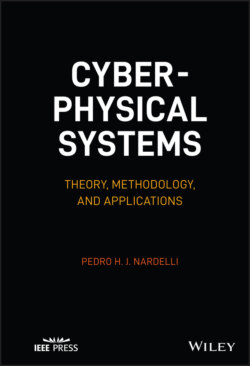Cyber-physical Systems

Реклама. ООО «ЛитРес», ИНН: 7719571260.
Оглавление
Pedro H. J. Nardelli. Cyber-physical Systems
Table of Contents
Guide
List of Illustrations
List of Tables
Pages
Cyber‐physical Systems. Theory, Methodology, and Applications
Preface
1 Introduction
1.1 Cyber‐Physical Systems in 2020
1.2 Need for a General Theory
1.3 Historical Highlights: Control Theory, Information Theory, and Cybernetics
1.4 Philosophical Background
1.5 Book Structure
1.6 Summary
Exercises
References
2 System
2.1 Introduction
2.2 Systems Engineering
2.3 Demarcation of Specific Systems
2.4 Classification of Systems
2.4.1 Natural and Human‐Made Systems
2.4.2 Material and Conceptual Systems
2.4.3 Static and Dynamic Systems
2.4.4 Closed and Open Systems
2.5 Maxwell's Demon as a System
2.5.1 System Demarcation
2.5.2 Classification
2.5.3 Discussions
2.6 Summary
Exercises
References
3 Uncertainty
3.1 Introduction
3.2 Games and Uncertainty
3.3 Uncertainty and Probability Theory
3.4 Random Variables: Dependence and Stochastic Processes
3.5 Summary
Exercises
References
4 Information
4.1 Introduction
4.2 Data and Information
4.3 Information and Its Different Forms
4.3.1 Mathematical Information and Communication
4.3.2 Semantic Information
4.3.3 Biological Information
4.3.4 Physical Information
4.4 Physical and Symbolic Realities
4.5 Summary
Exercises
References
5 Network
5.1 Introduction
5.2 Network Types
5.2.1 Peer‐to‐Peer Networks
5.2.2 One‐to‐Many, Many‐to‐One, and Star Networks
5.2.3 Complete and Erdös–Rényi Networks
5.2.4 Line, Ring, and Regular Networks
5.2.5 Watts–Strogatz, Barabási–Albert and Other Networks
5.3 Processes on Networks and Applications
5.3.1 Communication Systems
5.3.2 Transportation in Cities
5.3.3 Virus Propagation and Epidemiology
5.4 Limitations
5.4.1 From (Big) Data to Mathematical Abstractions
5.4.2 From Mathematical Abstractions to Models of Physical Processes
5.4.3 Universality and Cross‐Domain Issues
5.5 Summary
Exercises
References
6 Decisions and Actions
6.1 Introduction
6.2 Forms of Decision‐Making
6.3 Optimization
6.4 Game Theory
6.5 Rule‐Based Decisions
6.6 Limitations
6.7 Summary
Exercises
References
7 The Three Layers of Cyber‐Physical Systems
7.1 Introduction
7.2 Physical Layer, Measuring, and Sensing Processes
7.3 Data Layer and Informing Processes
7.4 Decision Layer and Acting Processes
7.5 Self‐developing Reflexive–Active System and Cyber‐Physical Systems
7.6 Layer‐Based Protocols and Cyber‐Physical Systems Design
7.7 Summary
Exercises
References
8 Dynamics of Cyber‐Physical Systems
8.1 Introduction
8.2 Dynamics of Cyber‐Physical Systems
8.2.1 Elementary Cellular Automaton
8.2.2 Example of a Cyber‐Physical System
8.2.3 Observable Attributes and Performance Metrics
8.2.4 Optimization
8.3 Failures and Layer‐Based Attacks
8.4 Summary
Exercises
References
9 Enabling Information and Communication Technologies
9.1 Introduction
9.2 Data Networks and Wireless Communications
9.2.1 Network Layers and Their Protocols
9.2.2 Network: Edge and Core
9.2.3 IoT, Machine‐Type Communications, and 5G
9.3 Artificial Intelligence and Machine Learning
9.3.1 Machine Learning: Data, Model, and Loss Function
9.3.2 Formalizing and Solving a ML Problem
9.3.3 ML Methods
9.4 Decentralized Computing and Distributed Ledger Technology
9.4.1 Federated Learning and Decentralized Machine Learning
9.4.2 Blockchain and Distributed Ledger Technology
9.5 Future Technologies: A Look at the Unknown Future
9.5.1 Quantum Internet
9.5.2 Internet of Bio‐Nano Things
9.5.3 After Moore's Law
9.6 Summary
Exercises
References
10 Applications
10.1 Introduction
10.2 Cyber‐Physical Industrial System
10.2.1 Tennessee Eastman Process
10.2.2 Tennessee Eastman Process as a Cyber‐Physical System
10.2.3 Example of Fault Detection in the TEP
10.3 Cyber‐Physical Energy System
10.3.1 Electricity Power Grid as a System
10.3.2 Frequency Regulation by Smart Fridges
10.3.3 Challenges in Demand‐Side Management in Cyber‐Physical Energy Systems
10.4 Other Examples
10.4.1 Cyber‐Physical Public Health Surveillance System
10.4.2 Mobile Application for Real‐Time Traffic Routes
10.5 Summary
Exercises
References
Note
11 Beyond Technology
11.1 Introduction
11.2 Governance Models
11.2.1 Markets
11.2.2 Central Planning
11.2.3 Commons
11.2.4 Final Remarks About Governance Models
11.3 Social Implications of the Cyber Reality
11.3.1 Data Ownership
11.3.2 Global Platforms
11.3.3 Fake News
11.3.4 Hybrid Warfare
11.4 The Cybersyn Project
11.5 Summary
Exercises
References
12 Closing Words
12.1 Strong Theory Leads to Informed Practices
12.2 Open Challenges in CPSs
12.3 CPSs and the Fourth Industrial Revolution
12.4 Building the Future
Exercises
Index
WILEY END USER LICENSE AGREEMENT
Отрывок из книги
Pedro H. J. Nardelli
The history of the manuscript is the following. The very first, preliminary version of the manuscript‐to‐be was presented as tutorial notes in the 2017 International Symposium on Wireless Communication Systems in Bologna (Italy). Then, this tutorial text was extended to become the lecture notes of a completely new course I had the freedom to develop at LUT as soon as I moved from the University of Oulu to LUT in 2018; the course is called Introduction of IoT‐based Systems. In 2020, I decided to convert those notes into a real book, which Wiley kindly accepted to publish.
.....
Example 1.2 Differences between daily language, philosophical categories, and scientific concepts. One word that exemplifies very well the difference is time. We use word time in many ways in our daily lives: to discuss about our activities, plans, routine, and the like. However, in philosophy, the category Time has different roles depending on the philosophical system to be considered – this usually comes with the relation between other categories like Causality, Origin, and End. In sciences, time is also a concept in different disciplines. In physics, time is a very precise concept that has been changing throughout its history, changing (not without pain) from the classical definition that time is an absolute measure (i.e. the same everywhere) to today's relativity theory where time is relative (and the speed of light is absolute). Such a scientific definition of the concept of time is not intuitive at all, and goes against most of our immediate use of the word. In this sense, scientists may find it difficult to operate with the scientific concept of time in relativity theory because of the other more usual meanings of the word. Besides, such a confusion between the scientific and the nonscientific may open philosophical questions and nonscientific interpretations of the scientific results.
In addition to this unavoidable challenge, the rationalization required by scientific theories appears in different forms. In this case, philosophical practice can help scientific practice by classifying the different types of rationality depending on the object under consideration. Motivated by Lepskiy [11] (but understood here in a different manner) and Althusser [8], we propose the following division.
.....